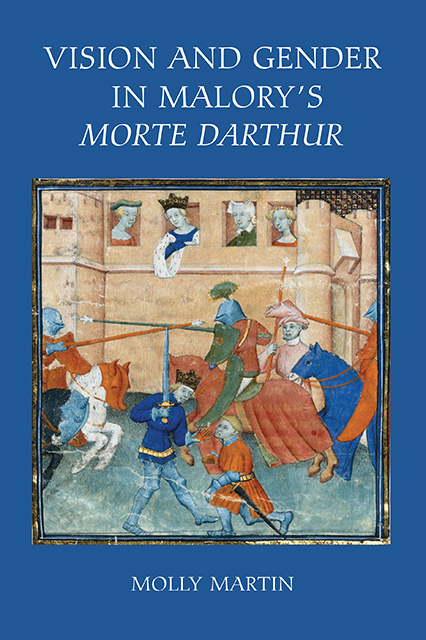Book contents
- Frontmatter
- Contents
- Acknowledgments
- Editorial Note
- Introduction: Masculinity and Vision in the Morte Darthur
- 1 “Beholdyng” Gareth: The Spectacle of Romance Masculinity
- 2 Gazing at the Queen: Trystram and Launcelot
- 3 Seeing Unseen: Palomydes and the Failure of Masculine Display
- 4 Romancing Religion: Competing Modes of Vision on the Grail Quest
- 5 The Female Gaze: Constructing Masculinity with and without Men
- Conclusion: Malory’s Arthurian Visions of Masculinity
- Bibliography
- Index
- Miscellaneous Endmatter
Conclusion: Malory’s Arthurian Visions of Masculinity
Published online by Cambridge University Press: 01 March 2023
- Frontmatter
- Contents
- Acknowledgments
- Editorial Note
- Introduction: Masculinity and Vision in the Morte Darthur
- 1 “Beholdyng” Gareth: The Spectacle of Romance Masculinity
- 2 Gazing at the Queen: Trystram and Launcelot
- 3 Seeing Unseen: Palomydes and the Failure of Masculine Display
- 4 Romancing Religion: Competing Modes of Vision on the Grail Quest
- 5 The Female Gaze: Constructing Masculinity with and without Men
- Conclusion: Malory’s Arthurian Visions of Masculinity
- Bibliography
- Index
- Miscellaneous Endmatter
Summary
This study of the intersections of vision and gender in Malory's Morte Darthur has endeavored to show that a coherent romance model of seeing and being seen governs the actions of knights and ladies in the constructions of their gender identities. This investigation has followed the text's many sightlines between images and viewers to highlight positive and negative impacts that intromissive vision has on the productions of femininity and especially masculinity. The dual fissures of sightlines and masculinity complicate medieval ideologies of gender, and the strict associations of male with masculine and female with feminine break down as the blurred lines unsettle social expectations of gender. In order to resituate individual and social gender identities in a comfortable manner, the moment of the collapsed gaze becomes a catalyst for highly visible narrative movement in Malory's romance. Through repetitive and ritualized scenes of masculine spectacle, most often on battle and tournament fields, Malory's knights iteratively perform maleness. Integral to this performance are the carefully layered audiences – the beloved ladies, fellow knights of the Round Table, opponent knights, assorted onlookers, narrator, and readers – who “beholde who dud beste and thereon to gyff a jugemente”. Their judgments not only reflect tournament prize winners, but also participate in the evaluation and confirmation of masculine identity. Malory and the Morte's Arthurian community possess an instinctual awareness about this need for visibility, the need to harness a viewership in order to perform and display one's gender identity. Indeed what dominates as a specifically male mechanism proves useful for analyzing female gender production as well. Malory's women, like his men, force their way in the visual sphere and produce the more variegated versions of their own gender. The model proves so pervasive that it coexists with spiritual forms of vision on the grail quest. Indeed, despite the diversity of the book, the Morte is unified by romance vision. Malory finds the tools for reconstructing masculinity within the bounds of romance, thus protecting normative gender structures. Malory possesses an acute awareness of gender possibilities within the romance genre. This study thus necessarily, if tangentially, enters into the debate about the genre of the Morte.
- Type
- Chapter
- Information
- Vision and Gender in Malory's Morte Darthur , pp. 175 - 180Publisher: Boydell & BrewerPrint publication year: 2010



